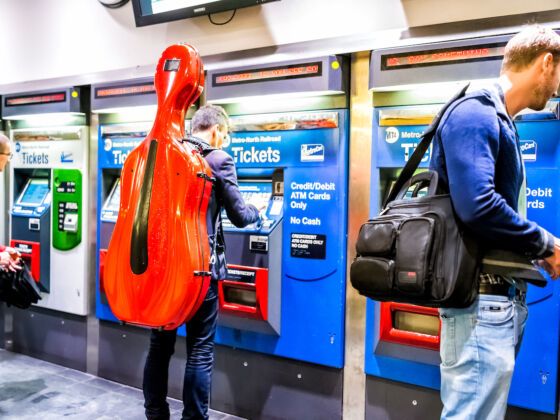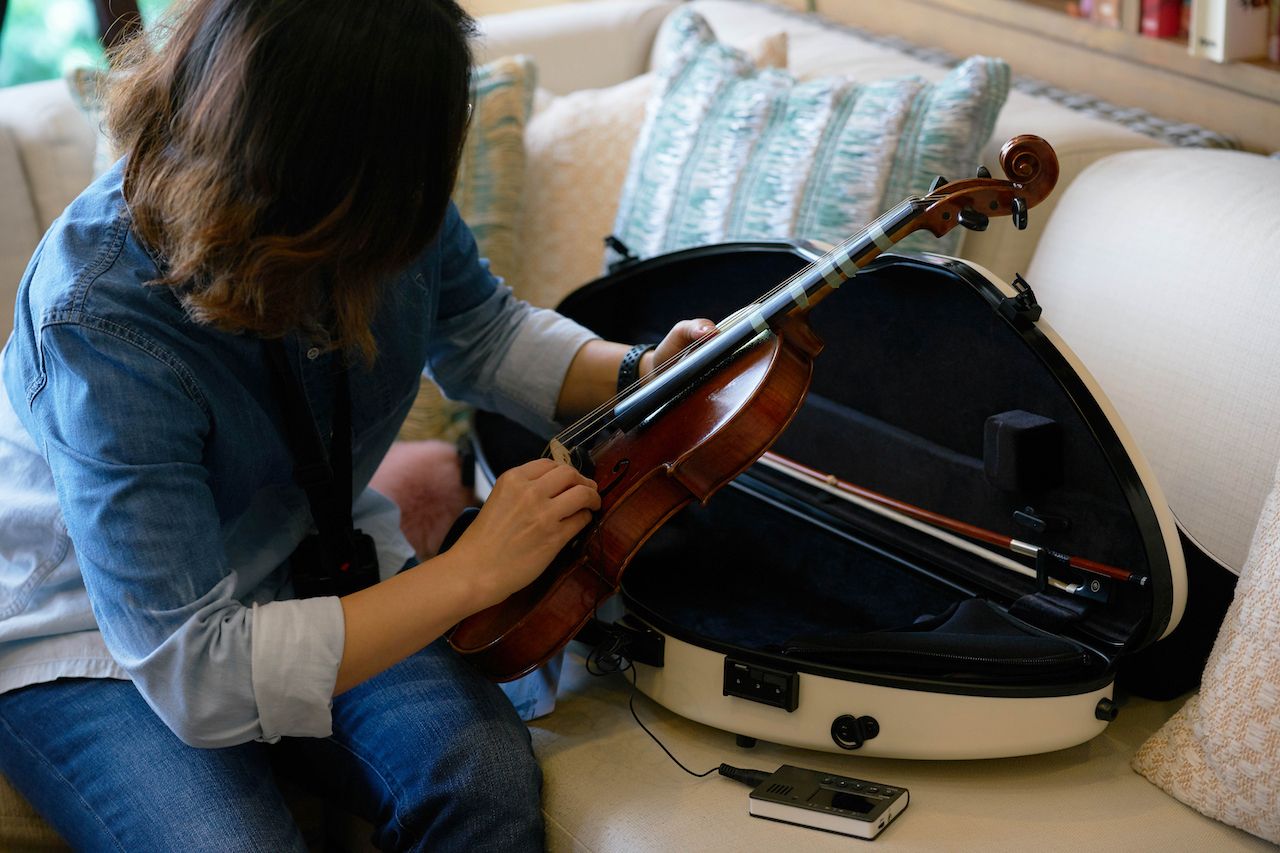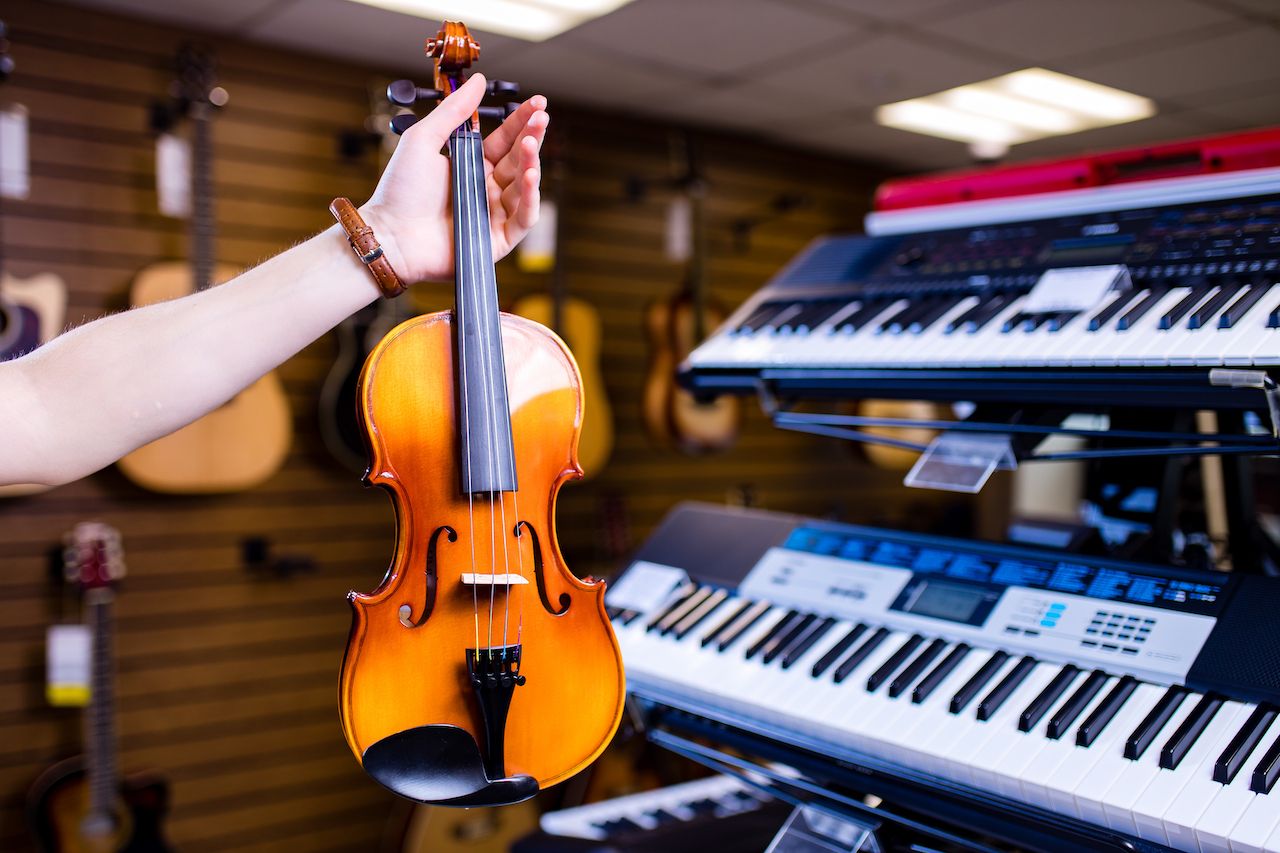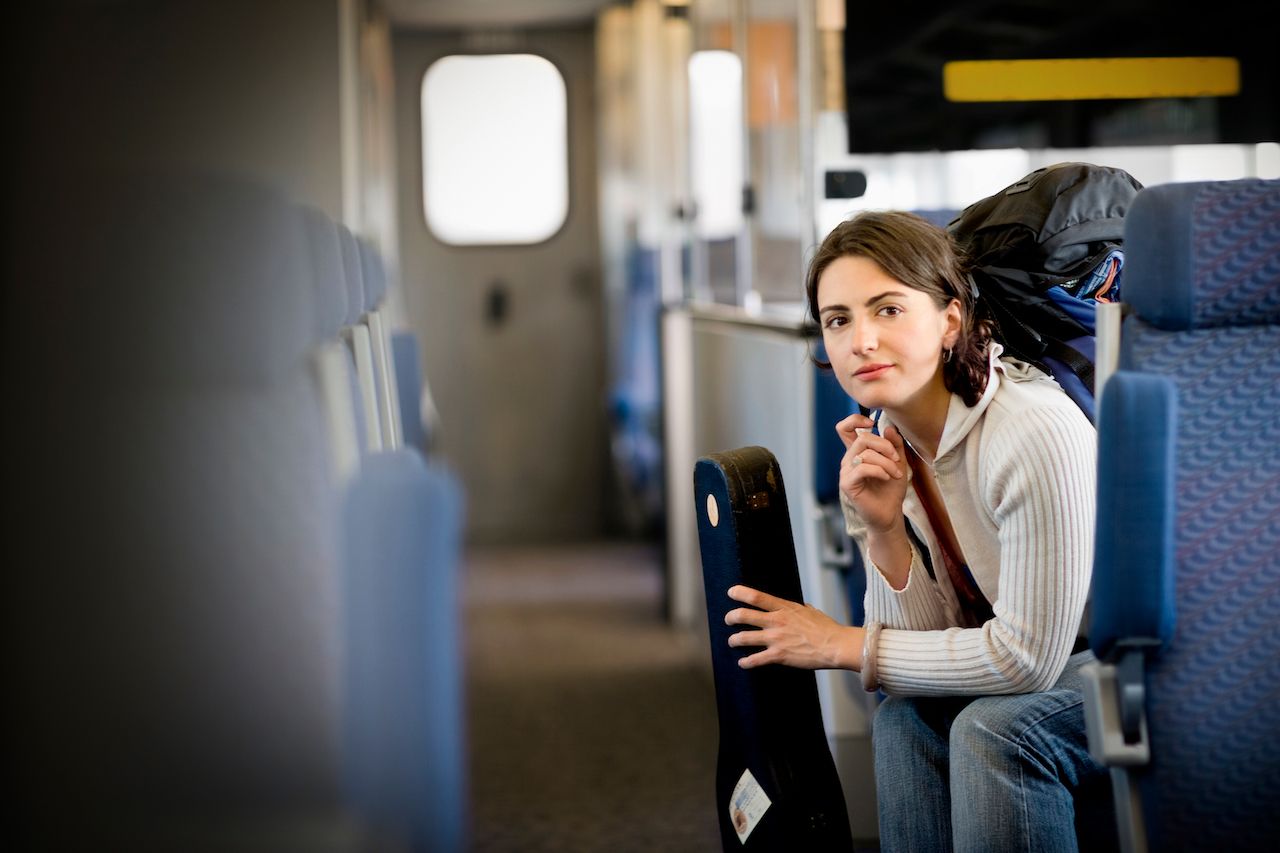I Tried To Fly With an Instrument. Here’s What I Wish I Knew Before Booking.

I had it all planned. I was only going to take my backpack and my violin with me to France. It was my first time traveling with an instrument, so the day before my departure, I packed my music and made sure my violin, bows, and accessories were secured in my case. I went to bed confident in my preparedness.
My violin teacher, a professional musician, had assured me that I would be able to fly with my violin without any problem. That I could take it on the plane along with a small backpack for no extra charge. She’d done it dozens of times before. But in the middle of the night before the big day, I woke up full of doubts. I picked up my phone and checked the requirements for traveling with an instrument on Air Canada.
- the instrument fits in the overhead bin or under the seat in front of you, or
- you purchase a seat to accommodate it.”
I had the sudden vision of my case not fitting inside the overhead bin (it definitely does not fit under an airplane seat). I verified the carry-on size requirements as advised, got out of bed to find a tape measure, and proceeded to check the dimensions of my violin case. It was too big.
There was no way I was going to chance it and take my violin on an eight-hour drive to the airport to find out I had to buy a seat for it or risk damaging the instrument by checking it. While seats for musical instruments on the Canadian flagship airline get a 50 percent discount, it was still an awful lot of money to spend at the last minute. So, I left my violin at home and hit the road.
It turns out that for many airlines based in the United States, taking an instrument along with you can be even more expensive than on Air Canada.
Matador’s Newsletter
Subscribe for exclusive city guides, travel videos, trip giveaways and more!
You’ve been signed up!
Follow us on social media.
Traveling with an instrument on a US airline
American Airlines
If you travel with an instrument as a carry-on on American Airlines, you need to make sure it either fits under the seat in front of you or in the overhead bin. Since the size of overhead bins vary depending on airplanes, you’d need to check your ticket for the airplane you’re flying and then check the size of the bin of said airplane (an Embraer 170, for example, is much smaller than a Boeing 767). Start with the airline’s carry-on size restrictions and adjust from there.
Buying an additional seat for your instrument on American Airlines will cost you the regular adult fare plus any applicable taxes or carrier-imposed fees. Note that you can only buy a seat if the instrument is 165 pounds or less.
If you prefer to check your instrument or have no choice due to its size, you may have to pay the fee for checked luggage. Note that your instrument cannot exceed 25 inches high by 40 inches wide, or 25 inches by 38 inches if you’re flying in an Embraer 170, due to the minimum size of the cargo hold doors.
United Airlines
Traveling with an instrument on United Airlines follows roughly the same rules as American Airlines. The United Airlines website states: “You can carry a violin, guitar or other small musical instrument on board if it’s in a hard case. These instruments will count as a carry-on bag if placed in the overhead bin. If placed in the seat in front of you, they’ll count as a personal item.” Whether the lack of precise information means the crew will be more accommodating when you show up with your instrument is not immediately clear.
You’re required to buy a seat for “large or valuable musical instruments,” though there’s no indication of what “large” or “valuable” might mean in this case. Note that the seat must be booked in advance and you’ll pay applicable charges. In this case, the instrument cannot exceed 165 pounds.
Delta Air Line
On Delta Air Lines, guitars, violins, flutes, and small musical instruments are accepted as a free carry on bag. Like the other airlines, your instrument must fit in the overhead bin or under the seat in front of you.
Your instrument’s length, width, and height cannot exceed 150 inches (78.74 inches if you’re traveling on the 767-300 aircraft to or from Tokyo-Narita airport) and must be 165 pounds or lighter. If your instrument is bigger than those dimensions, it’ll need to be checked as oversized/overweight luggage. If checking your instrument sounds like your worst nightmare and it’s less than 165 pounds, you can book a seat for it — it will cost the same as a full-fare ticket, however.
Southwest Airlines
You can take your instrument on board a Southwest Airlines flight as a carry-on if it fits into an overhead bin or under the seat in front of you — and if there is space for it. If not, you need to either buy a seat for it (there’s no mention of the fee on the website) or check the instrument (it can be used as your one free checked bag that Southwest allows). Any musical instrument with a length, width, and height between 62 and 150 inches, and weighs between 51 and 165 pounds, is subject to an oversized/overweight baggage fee.
A professional musicians’ tips for traveling with an instrument
Professional violinist Natasha Hall has traveled around the world with her instrument. Originally from Western Canada, Hall studied at Carnegie Mellon University in Pittsburgh and was part of several orchestras in London. She has performed around Europe, North America, and Asia.
We talked to Hall to learn more about how musicians travel with their instruments and to get some tips on how to do it as smoothly as possible.
Flying with a valuable violin
When she flies, Hall’s violin is her main piece of carry-on luggage. Her violin case fits in the overhead compartment, but not under the seat in front of her. Hall explains that she usually tries to board the plane ahead of other passengers so she has room to fit her violin in one of the overhead bins before everyone else packs them with roller bags. On the times the overhead bins have been full, crew members stored her violin in one of their closets.
Although Hall has rarely run into big issues when flying with her violin, she explains that she always has doubts about what will happen once she boards an airplane. She’s never sure there will be room for her violin in the overhead compartment — or if it will even fit — and she doesn’t know if the crew will make her check her instrument. The only time she ran into such a problem was when boarding a flight out of Spokane, Washington. The plane was already full when she boarded, and a crew member told her to check her instrument or leave the aircraft, which she refused to do. “It was an embarrassing conversation to have in front of all the other passengers,” she says. Luckily, a generous traveler took out his luggage and checked it for her to have the space to fit her violin.
While some string musicians loosen the tension on the strings before a flight, Hall never does so. Instead, she uses a humidifier to control the moisture level and prevent her violin from cracking in the airplane’s dry air. The humidifier can be placed inside the instrument itself or in the case.
Hall plays a Francesco Ruggieri violin that was made in 1680 and is loaned to her from the Jumpstart Jr. Foundation. It’s an extremely valuable violin that needs to be protected at all times. Note that a valuable instrument like Hall’s should never be checked. If you’ve seen how luggage is handled by the people in charge of cargo, you know why.
To make sure her violin is safe, Hall uses a lightweight and waterproof Gewa hard-shell case with a combination lock. Although she’s not 100 percent satisfied with the case (some safety aspects could be improved), it does the job and can be carried on her back like a backpack when she commutes or travels.
Crossing borders with an instrument
If your instrument is very valuable, you need to carry paperwork with you when crossing international borders so customs agents can verify its provenance and ownership. Once, while flying out of Moscow with members of an orchestra, Hall was stopped by a customs agent. At the time, she was playing a violin by Honoré Derazey with a fake Stradivarius label (which is not an uncommon occurrence in the violin world). When the customs officer saw the label, he thought she was smuggling a multi-million dollar violin out of the country, and it took her a long time to get out of the nerve-wracking situation.
“I’m just glad that I was able to actually leave Russia,” she says, “because for a while I was not sure I’d ever make it out — as much as I like Russia!”
Checklist for traveling with an instrument

- Get a good case: No matter where you’re going and how you’re getting there, you need to get your instrument a good case. Hard-shell cases can be very expensive, but if you value your instrument, it’s a must-have. Many also have a locking system with a combination code, which adds an extra layer of safety. Note that airlines usually require travelers to place instruments in hard-shell cases.
- Before flying: If you have any doubts, call the airline when booking your trip. Make sure you have read all the requirements and have the dimensions of your instrument ready. You should get all the info you need from them before your trip so there’s no surprise upon boarding.
- Boarding an airplane with an instrument: Most airlines recommend those who travel with an instrument as a carry-on to board first. Go to the agent at the gate and explain that you are bringing your instrument as a carry-on and want to board early to place it safely in an overhead compartment. This way, you’ll be sure to have the safe space you need for your instrument. If you board later and there’s no room in the overhead compartment for your instrument, you may need to check it.
- In the airplane: If you don’t have a choice but to buy an airplane seat for your instrument, you’ll need to secure it in its case with the seatbelt (and possibly other straps if the instrument is large, like a cello) and make sure it doesn’t obstruct exits or signage. A properly secured case is not only good for the instrument, but for all the people in the airplane who have no desire to get hit by a loose hard-shell case during take-off or turbulence. It’s also worth remembering that most airlines require your instrument to be on the seat directly beside you, and you can’t book an emergency row seat if you have your instrument as a cabin-seat baggage.
What you can do if you can’t fly with your instrument

If, like me, you’re giving up on bringing your instrument with you, there’s a simple alternative that can turn out to be great fun.
Upon arriving at my destination, I called the music shops in my area and asked if I could rent a student violin from them. While no shop carried violins, one of them gave me the number of a local luthier who would be able to help. I called and got an appointment almost right away. For less than $20 for four weeks, and a damage deposit of about $1200, I was able to rent a beautiful 1940s instrument.
I had never played a violin other than my own and the change was fun and quite eye-opening. Like my violin teacher says: “It’s like having a new voice.”
While this solution is not perfect, especially for professional or advanced musicians who need to travel with their own instruments, it’s a cheap and fun solution for amateur musicians who still want to practice on vacation.
Above all else, read the fine print

What I did the night before my trip, I should have done as soon as I booked my flight. That way, I would have been less rushed and able to read all that Air Canada had to say about traveling with an instrument.
Yes, my violin was much bigger than the carry-on size requirements, but at the very bottom of the page on Air Canada’s webpage about traveling with an instrument is a very small section that reads: “Exception: String instruments (e.g. guitars, violins and violas) can be carried on board – even if their dimensions slightly exceed Air Canada’s carry-on size requirements – as long as they fit in the overhead bin and there is space available in the cabin at time of boarding.”
So, here’s a lesson for all musicians out there: Read everything the airline has to say carefully.
Travel to Central and South America: A Reopening Timeline, Country by Country
Jamie Ditaranto is a freelance journalist, photographer, and full-time traveler. Before writing for TripSavvy, Jamie was the Editor of Video and Content for SmarterTravel.com, where she sought to share unique travel experiences like barge cruising in France and sleeping in centuries-old Japanese inns.
:max_bytes(150000):strip_icc()/crowds-line-up-at-caixa-economica-federal-to-receive-the-second-installment-of-the-urgent-government-benefit-due-to-the-coronavirus--covid---19--pandemic-1214194870-e96cd178c8514ff19394aeed4461b45a.jpg)
COVID-19 surged in many parts of South and Central America, where borders were closed and most commercial flights to the region were halted. While some countries remain closed, many others have reopened for international tourism. American travelers are welcome in most countries, so long as they can meet the testing and quarantine requirements for entry.
Read on for a country-by-country listing of border status, quarantine restrictions, and more information on travel throughout Central and South America.
Argentina
U.S. citizens are allowed to enter Argentina as long as they can show proof of vaccination and a negative PCR test taken within 72 hours. Another PCR test will be required for all travelers on their fifth day in Argentina. Before flying, travelers must also complete a sworn statement online. Any unvaccinated traveler, including minor children, entering Argentina must quarantine for seven days. All travelers arriving from any African country will also be required to take an antigen test on arrival and quarantine for 14 days.
Belize
U.S. citizens and all other foreign tourists are allowed to enter Belize with different entry requirements for each kind of traveler. Everyone traveling to Belize must show proof of vaccination or a negative PCR test taken within 96 hours. Tourists will only have the option of using approved Gold Standard hotels and tour operators and transportation will be pre-organized. After February 15, all visitors will be required to purchase health insurance.
Bolivia
Bolivia’s quarantine and travel restrictions vary from city to city. All travelers will need to have proof of medical insurance and a negative PCR test taken within 72 hours before their flight, depending on the traveler’s origin. Regardless of vaccination status, a minimum 10-day home quarantine is required. All travelers will need to disclose the location of their quarantine in a sworn statement and take a PCR test on the seventh day of the quarantine period.
Brazil
Foreigners, including U.S. citizens, are allowed to fly to Brazil. All travelers will be required to show a negative PCR test, however, unvaccinated travelers will be required to quarantine for five days and must be tested again at the end of the five days. All travelers must also complete the Traveler Health Declaration before checking into their flight.
Chile
Chile reopened to foreign tourists in October. All travelers will need to show proof of vaccination, complete the Affidavit of Travelers, and apply for a Mobility Pass, which could take up to four weeks to process. All travelers will be PCR tested on arrival and must quarantine at a hotel or private residence until they get a negative result back.
Non-resident foreigners arriving from South Africa, Zimbabwe, Namibia, Botswana, Lesotho, Eswatini, or Mozambique will not be allowed to enter Chile.
Colombia
All travelers above the age of 18 will need to be fully vaccinated to enter Colombia in addition to completing the online health form within 48 hours of boarding. Travelers who are not yet fully vaccinated, but have had at least one dose, can show a negative PCR test, taken within 72 hours, as an alternative.
Costa Rica
Costa Rica has opened up to all U.S. citizens and it is no longer necessary to show a negative test or quarantine. Only unvaccinated travelers are required to show proof of medical insurance and complete an online epidemiological form. Costa Rica’s immigration officials have the authority to determine the length of any visitor’s stay as it corresponds to the coverage dates of their insurance policy.
:max_bytes(150000):strip_icc()/ecuador-continues-on-alert-for-coronavirus-1214037929-5207a75c85ce4fc0849b8343e9697f7c.jpg)
Ecuador
Ecuador is open for all foreign tourists, but travelers will need to provide a vaccination card and a negative PCR test taken within three days before their arrival, or proof of recovery from COVID-19. Travelers presenting symptoms will be tested on arrival. If a traveler tests positive, they must isolate for 10 days. To visit the Galapagos, tourists will need either proof of vaccination or a negative test was taken within 72 hours of departure in addition to their transit control card. As of December 1, any traveler arriving from South Africa, Botswana, Egypt, Mozambique, Lesotho, Zimbabwe, Eswatini, or Namibia will not be allowed to enter Ecuador.
Guatemala
All foreign nationals, including U.S. citizens, will be allowed to enter Guatemala as long as they can show proof of vaccination and a negative test taken within 72 hours of arrival. There is no quarantine requirement. Guatemala has restricted travel from South Africa, Namibia, Botswana, Mozambique, Lesotho, Zimbabwe, Egypt, and Eswatini.
Honduras
U.S. citizens are allowed to enter Honduras but if they are not vaccinated, they will need to show a negative test taken within 72 hours. Only travelers showing symptoms will be required to quarantine. All travelers must also complete the immigration pre-check form and should print out their confirmation before departing for Honduras.
Nicaragua
The Nicaraguan government does not have any travel bans in place and most airlines have resumed service. U.S. citizens are allowed to enter Nicaragua if they can show a negative test result and do not need to quarantine if they are not showing symptoms.
Panama
Vaccinated travelers only need to show proof of vaccination to enter Panama. However, unvaccinated travelers from the U.S. must submit a negative PCR test before flying or they will be tested at the airport and required to quarantine for at least 72 hours, even if the results return negative. All travelers must sign an online affidavit before checking into their flight.
Panama has suspended entry from the following countries: South Africa, Botswana, Eswatini, Lesotho, Mozambique, Namibia, and Malawi.
Peruvian airports have reopened for international travel between Peru and the U.S. Regardless of vaccination status, all travelers over the age of 12 will need to show proof of vaccination or a negative test taken within 72 hours of their flight and sign an affidavit of health. U.S. citizens are not required to quarantine.
Uruguay
U.S. citizens may now enter Uruguay with proof of vaccination and a negative test taken within 72 hours. Unvaccinated travelers may enter, but they will be required to self-quarantine for at least seven days. On arrival, travelers will undergo a health screening and must present proof of health insurance in addition to completing the Online Health Declaration Form.
Venezuela
Americans with a visa are allowed to enter without quarantining but will need a negative PCR test taken within 48 hours of arrival.
TripSavvy uses only high-quality, trusted sources, including peer-reviewed studies, to support the facts within our articles. Read our editorial policy to learn more about how we keep our content accurate, reliable and trustworthy.
U.S. Embassy in Argentina. “COVID-19 Information.” January 12, 2022.
U.S. Embassy in Belize. “COVID-19 Information.” December 7, 2021.
Belize Tourism Board. “Belize COVID-19 Travel Updates.” August 9, 2021.
U.S. Embassy in Bolivia. “COVID-19 Information.” December 28, 2021.
U.S. Embassy & Consulates in Brazil. “COVID-19 Information.” January 13, 2022.
U.S. Embassy in Chile. “COVID-19 Information.” January 13, 2022.
U.S. Embassy in Colombia. “COVID-19 Information.” January 7, 2022.
U.S. Embassy in Costa Rica. “COVID-19 Information.” January 11, 2022.
U.S. Embassy & Consulate in Ecuador. “COVID-19 and Travel Information.” December 27, 2021.
Source https://matadornetwork.com/read/flying-with-instrument-before-booking/
Source https://www.tripsavvy.com/central-south-america-border-reopenings-4845678
Source